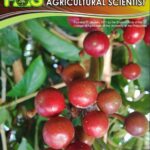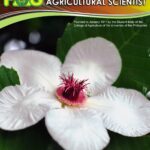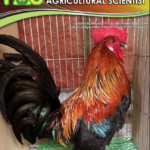Vol. 100, No. 1 (Mar 2017)
Flower-visiting insects on Diospyros blancoi: Background: Thrip (T. hawaiiensis) on female flower; Counterclockwise, from top right: Skipper (Suastus gremius) visiting female flower; Ant (Aphaenogaster sp.) on female flower; Ant (Crematogaster sp.) on female flower; pollen attached to the antenna; and T. hawaiiensis on male flower.
Categories
Articles
Genetic Diversity Analysis and DNA Fingerprinting of Pili (Canarium ovatum Engl.) using Microsatellite Markers
Carlo Miguel C. Sandoval, Evelyn Mae Tecson-Mendoza, and Roberta N. Garcia
Six microsatellite markers obtained from Canarium album and Carica papaya detected eight loci in the pili (Canarium ovatum Engl.) accessions with two markers, CasC120 and SSR38, each amplifying two loci. A total of 43 alleles (5.38 alleles per locus) were detected in the 79 pili accessions assayed, while only 3.25 alleles per locus were obtained in Canarium luzonicum and in seven pili varieties registered with the National Seed Industry Council (NSIC). Polymorphism information content (PIC) values of the markers were relatively high across accessions (0.57) and varieties (0.45), indicating the ability of the markers to detect genetic diversity in the population assayed. Gene diversity was...
Six microsatellite markers obtained from Canarium album and Carica papaya detected eight loci in the pili (Canarium ovatum Engl.) accessions with two markers, CasC120 and SSR38, each amplifying two loci. A total of 43 alleles (5.38 alleles per locus) were detected in the 79 pili accessions assayed, while only 3.25 alleles per locus were obtained in Canarium luzonicum and in seven pili varieties registered with the National Seed Industry Council (NSIC). Polymorphism information content (PIC) v...
Prominent Traits of Some F1 Hybrid Papaya Lines in Thailand
Rapatsa Janthasri, Suphachai Janloon, and Valerie Suwanseree
This study identified and compared characteristics of 10 F1 hybrid papayas that were obtained by crossing five cultivars selected for high yield and tolerance to Papaya ring spot virus (PRSV). The hybrids were tested at the Papaya Research and Development Center, Maha Sarakham Province, from January to December 2013. The results showed that hybrids No. 1 (‘Yellow Krang’ × ‘Red Krang’), No. 2 (‘Yellow Krang’ × ‘Khaek Dam’), No. 3 (‘Yellow Krang’ × ‘Florida’), No. 4 (‘Yellow Krang’ × ‘Khaek Nuan’) and No. 5 (‘Khaek Dam’ × ‘Khaek Nuan’) had good yield and fruit qualities but they were more susceptible to PRSV than hybrids No. 6 (‘Khaek Dam’ × ‘Florida’), No. 7 (‘Red Krang’ × ‘Florida’), No. ...
This study identified and compared characteristics of 10 F1 hybrid papayas that were obtained by crossing five cultivars selected for high yield and tolerance to Papaya ring spot virus (PRSV). The hybrids were tested at the Papaya Research and Development Center, Maha Sarakham Province, from January to December 2013. The results showed that hybrids No. 1 (‘Yellow Krang’ × ‘Red Krang’), No. 2 (‘Yellow Krang’ × ‘Khaek Dam’), No. 3 (‘Yellow Krang’ × ‘Florida’), No. 4 (‘Yellow Krang’ × ‘Khaek Nua...
Phylogeny and Evolutionary History of Brassica Species in China Based on Chalcone Synthase Gene (Chs) Sequence
Fa-Bo Chen, Shi-Ping Huo, Chang-Lei Cao, Hong-Fang Liu, Qi-Lun Yao, and Ping Fang
For many years, relationships within Chinese Brassica species and subspecies were the subject of much controversy. Sequences of the chalcone synthase gene (Chs) were used to analyze the evolutionary history of Brassica plants from China. Sequences from Brassica were separated into three well-supported groups in accordance with the A, B, and C genomes. SplitsTree analysis recognized three distinct Brassica groups, and median-joining network analysis recognized three distinct haplotypes of Chs. The estimates of Tajima’s D, Fu and Li’s D, and Fu and Li’s F statistics for the Chs gene between the A-diploid and C-diploid were not significant, while those between the A-polyploid and B-polyploid...
For many years, relationships within Chinese Brassica species and subspecies were the subject of much controversy. Sequences of the chalcone synthase gene (Chs) were used to analyze the evolutionary history of Brassica plants from China. Sequences from Brassica were separated into three well-supported groups in accordance with the A, B, and C genomes. SplitsTree analysis recognized three distinct Brassica groups, and median-joining network analysis recognized three distinct haplotypes of Chs....
Flower Visitors and Potential Major Pollinator of Diospyros blancoi A. DC. in Taiwan
Sheng-Feng Hung, Tsu-Liang Chang, Hen-Biau King, and Iou-Zen Chen
At least eight arthropod species belonging to five taxa as flower visitors of Diospyros blancoi A. DC. were investigated in terms of their visiting frequency, activities on the flowers and pollen-bearing capacity. The main results of this study are as follows: First, thrips particularly Thrips hawaiiensis (Morgan) (Thysanoptera: Thripidae), and ants showed the highest visiting frequency; Second, the long pollination distance and the fruit-set on single female trees isolated by water barriers indicate that arboreal ants were not pollinators; Third, thrips species other than T. hawaiiensis were not observed in this study; Fourth, male flowers provided shelter (flower tube) and food (pollen)...
At least eight arthropod species belonging to five taxa as flower visitors of Diospyros blancoi A. DC. were investigated in terms of their visiting frequency, activities on the flowers and pollen-bearing capacity. The main results of this study are as follows: First, thrips particularly Thrips hawaiiensis (Morgan) (Thysanoptera: Thripidae), and ants showed the highest visiting frequency; Second, the long pollination distance and the fruit-set on single female trees isolated by water barriers ...
Effects of Novel Synthetic Pyrazolopyrimidine Compounds against Pepper Mild Mottle Virus (PMMoV) Infecting Vegetable Crops and Human Pathogens
Essam K. F. Elbeshehy, Abdullah A. AL-Jaddawi, and Abdullah S. Al-Bogami
Pepper mild mottle virus (PMMoV) was obtained from naturally infected pepper (Capsicum annuum L.). Plants with mosaic, puckering and mottling yellow or light green symptoms on the upper developing leaves were collected from the Mecca regions, Kingdom of Saudi Arabia. Infected samples were carefully tested by direct enzyme-linked immunosorbent assay (ELISA) with antiserum to Tobacco mosaic virus (TMV), Cucumber mosaic virus (CMV), Potato virus Y (PVY), Tobacco etch virus (TEV), Tomato spotted wilt virus (TSWV) and Pepper mild mottle virus and confirmed by electron microscopy and reverse transcription-polymerase chain reaction (RT-PCR) assay. On the other hand, we studied inhibitory effects...
Pepper mild mottle virus (PMMoV) was obtained from naturally infected pepper (Capsicum annuum L.). Plants with mosaic, puckering and mottling yellow or light green symptoms on the upper developing leaves were collected from the Mecca regions, Kingdom of Saudi Arabia. Infected samples were carefully tested by direct enzyme-linked immunosorbent assay (ELISA) with antiserum to Tobacco mosaic virus (TMV), Cucumber mosaic virus (CMV), Potato virus Y (PVY), Tobacco etch virus (TEV), Tomato spotted ...


